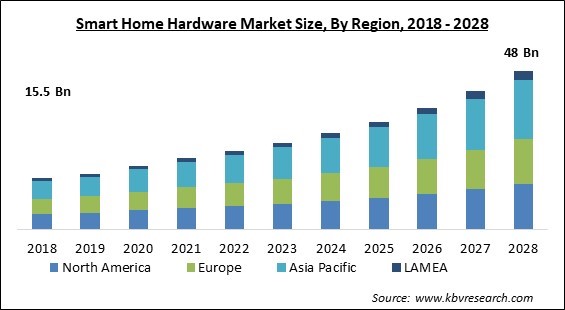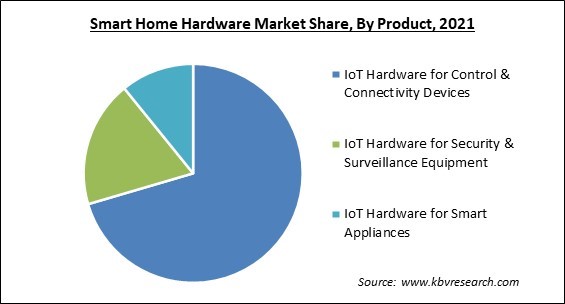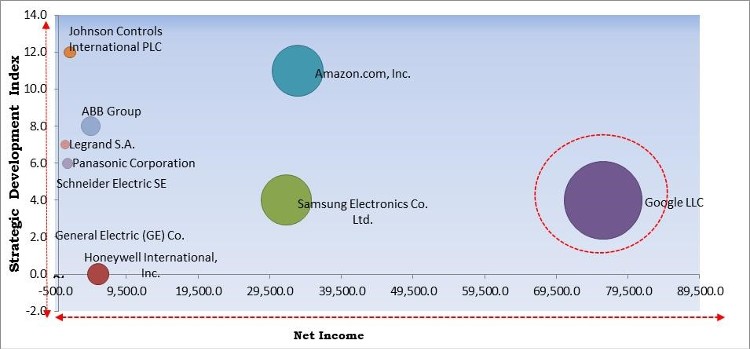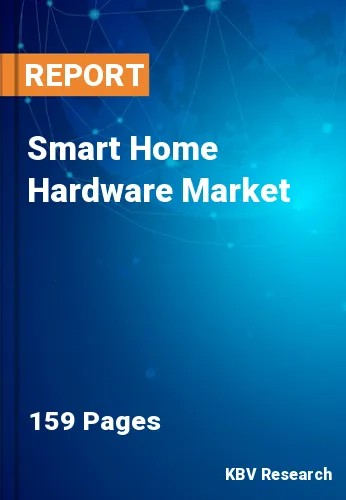The Global Smart Home Hardware Market size is expected to reach $48 billion by 2028, rising at a market growth of 12.5% CAGR during the forecast period.
Smart home hardware offers various advantages, including the capacity to handle all devices from a single location, increased home security, high energy efficiency, and remote control for all tasks. It can also be utilized for remote monitoring via a laptop, mobile device, or desktop computer. It is popular because it is energy efficient and can handle multiple tasks at once. The smart home hardware are driven by the increasing use of smart home devices and the rising importance of home monitoring systems. Other factors driving market demand include the rising growth of broadband and the widespread use of smartphones to manage smart devices remotely.
The gadgets that operate as the brains of a smart home system, processing, and sensing data and communicating wireless, are known as smart home hardware. It's a smart device which can connect to smart home systems, communicate with other devices, and make a decision on its own. The smart home hardware is linked to the internet, stores data in the cloud, and responds to the user's actions. Televisions, alarm systems, doorbells, speakers, and other devices and appliances are among them. Smart home devices are appropriate for a home setup in which devices may be operated remotely utilizing a mobile or other networked device from any Internet-connected location in the world. The consumer can control features such as security access, lighting, temperature, and home theater in a smart home by connecting its gadgets to the Internet.
The 'new normal,' as described by the social distancing practice, forced real estate firms and the architect ecosystem to get back to the drawing board and re-imagine residential real estate products by incorporating new-age design, innovation, and efficiency. The necessity for a whole new set of amenities has reappeared and gained relevance as the makeover takes place. In the aftermath of the COVID-19 pandemic, what the consumer would need in the 'new normal' has experienced a revolution, resulting in a paradigm shift in living environments.

The spread of COVID-19 pandemic has had a favorable impact on the smart home hardware market. The orders and shipments for voice control devices have increased by a significant rate. For instance, as per Xiaomi research, more than 51% of customers purchased at minimum one smart home gadget at the time of the COVID-19 pandemic. COVID-19 has thrown a wrench in everyday life, forcing individuals, organizations, and governments to rethink the policies, goals, and actions. Such advances are encouraging technical improvement and innovation. Although, in current history, the home automation industry has risen significantly, spurred in part by COVID-19 and the reality that lockout limitations have pushed individuals to invest additional time in the houses. Due to reasons like more enterprises entering the market and a growing proportion of online and internet sales, the industry has grown to include a broad range of low-cost home automation and mid-range and entry-level products.
One of the most important overall economic drivers for smart home hardware market growth is the Internet of Things platform. This IoT-based technology offers energy-saving capabilities at home. For instance, as per IoT connections will reach a significant level of multiple billion in coming years. The factor indicates that enormous clusters of devices, sensors, and objects will interact via high-speed technologies such as 5G in a few years. The market is experiencing a substantial growth in number of IoT devices. With the evolving period of time, various smart hardware devices are incorporating the solutions of the internet of things.
The huge reach of home automation devices has occurred due to technological advancements and improved security alternatives. With the emergence of innovative wireless technologies such as ZigBee and Bluetooth, the creation of automated control systems has been simplified, and multiple standards for home automation controls, such as EnOcean and Z-wave, have expanded the flexibility of diverse components. The growth of the market is anticipated to be accelerated by growing implementation of home monitoring systems, increasing the requirement for home monitoring from remote areas, and rising consumer awareness of the comfort of smart home devices, such as lighting and automated security systems.
The growing cyber-attack in high-end connected technology is a big barrier to commercial expansion. All of the linked endpoints pose a security risk to smart home technology. As the intelligent technology is linked to each and every system and gadget in the home, hackers can obtain access to sensitive and personal data if it is not fully protected. For instance, as per Rambus Incorporated, a chip interface technology designer, developer, and licenser, a significant amount of IoT devices are prone to a range of attacks. Connecting previously standalone smart devices such as lighting, appliances, and locks raises a slew of new cyber security issues.

Based on Product, the market is segmented into IoT Hardware for Control & Connectivity Devices, IoT Hardware for Security & Surveillance Equipment, and IoT Hardware for Smart Appliances. The IoT hardware for smart appliances segment acquired a substantial revenue share in the smart home hardware market in 2021. The COVID-19 pandemic has boosted demand for smart appliances even more as most people now work from home, resulting in greater investment in smart appliances. In addition, because smart home appliances may be operated remotely, it has a significant need for IoT hardware for smart appliances, which leads to market growth.
| Report Attribute | Details |
|---|---|
| Market size value in 2021 | USD 21.6 Billion |
| Market size forecast in 2028 | USD 48 Billion |
| Base Year | 2021 |
| Historical Period | 2018 to 2020 |
| Forecast Period | 2022 to 2028 |
| Revenue Growth Rate | CAGR of 12.5% from 2022 to 2028 |
| Number of Pages | 159 |
| Number of Tables | 173 |
| Report coverage | Market Trends, Revenue Estimation and Forecast, Segmentation Analysis, Regional and Country Breakdown, Competitive Landscape, Companies Strategic Developments, Company Profiling |
| Segments covered | Product, Region |
| Country scope | US, Canada, Mexico, Germany, UK, France, Russia, Spain, Italy, China, Japan, India, South Korea, Singapore, Malaysia, Brazil, Argentina, UAE, Saudi Arabia, South Africa, Nigeria |
| Growth Drivers |
|
| Restraints |
|
Based on Regions, the market is segmented into North America, Europe, Asia Pacific, and Latin America, Middle East & Africa. The Asia Pacific emerged as the leading region in the smart home hardware market with the largest revenue share in 2021. Smart refrigerators, washing machines, kitchen appliances, and other smart house hardware are created with technological advancements and are very inexpensive in the region, resulting in a large desire for the smart home hardware market. Moreover, in the Asia Pacific, economic growth, rapid urbanization, and a large telecom industry have raised the demand for smart home devices.
Free Valuable Insights: Global Smart Home Hardware Market size to reach USD 48 Billion by 2028

The major strategies followed by the market participants are Partnerships. Based on the Analysis presented in the Cardinal matrix; Google, LLC. are the forerunners in the Smart Home Hardware Market. Companies such as Samsung Electronics Co., Ltd., ABB Group are some of the key innovators in the Market.
The market research report covers the analysis of key stake holders of the market. Key companies profiled in the report include Google LLC, Amazon.com, Inc., Schneider Electric SE, Honeywell International, Inc., ABB (ASEA Brown Boveri) Group, Johnson Controls International PLC, Panasonic Corporation, Legrand S.A., Samsung Electronics Co. Ltd., and General Electric (GE) Co.
By Product
By Geography
The smart home hardware market size is projected to reach USD 48 billion by 2028.
Huge development in technologies are driving the market in coming years, however, greater security risks are impeding market expansion growth of the market.
Google LLC, Amazon.com, Inc., Schneider Electric SE, Honeywell International, Inc., ABB (ASEA Brown Boveri) Group, Johnson Controls International PLC, Panasonic Corporation, Legrand S.A., Samsung Electronics Co. Ltd., and General Electric (GE) Co.
The IoT Hardware for Security & Surveillance Equipment segment is showcasing a CAGR of 12.8% during (2022 - 2028).
The Asia Pacific segment acquired maximum revenue share in the Global Smart Home Hardware Market by Region in 2021, and would continue to be a dominant market till 2028.
Our team of dedicated experts can provide you with attractive expansion opportunities for your business.

